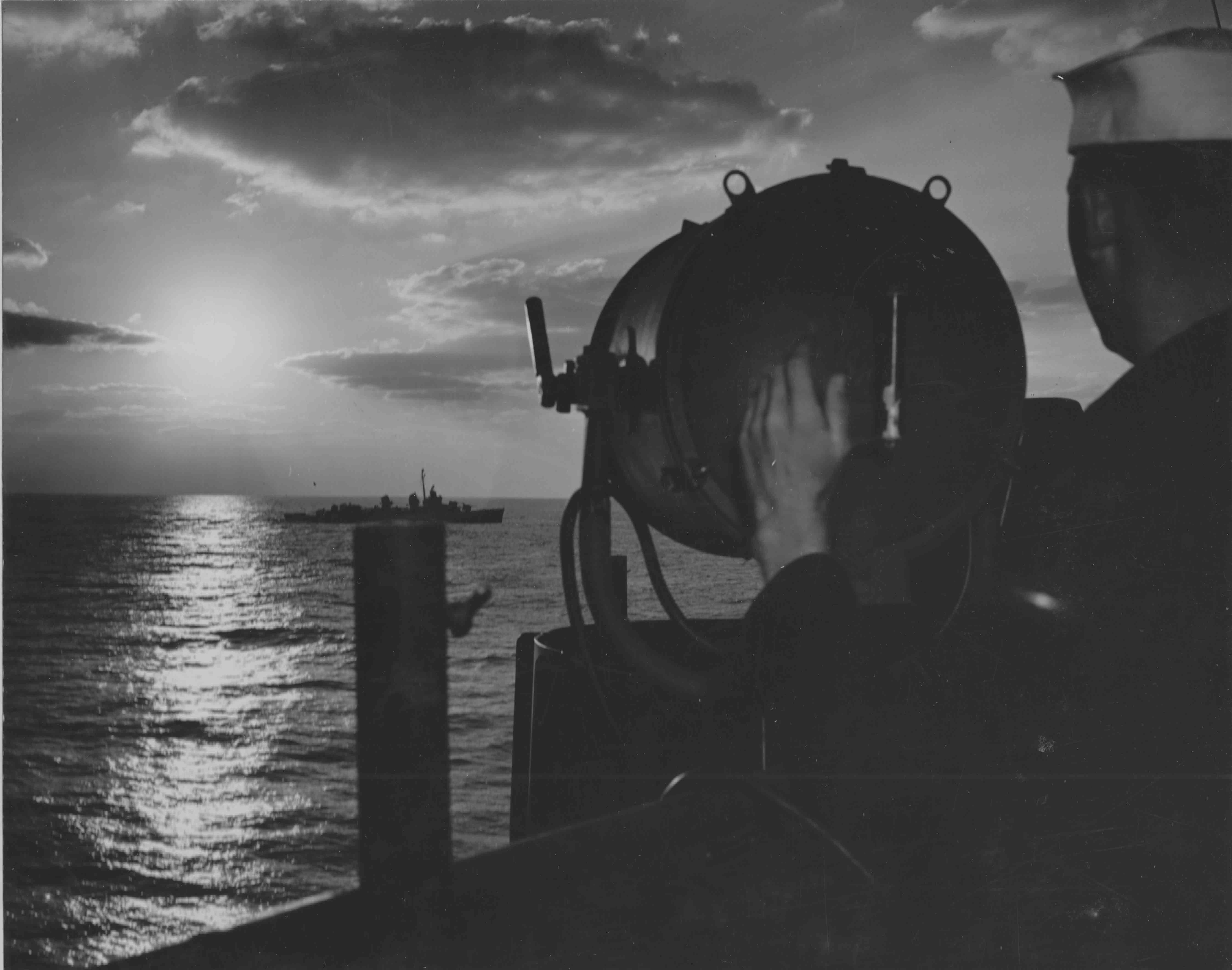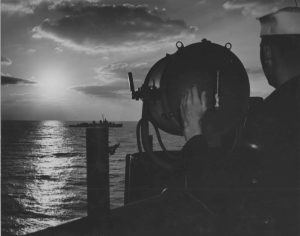Five days ago, the wreckage of light cruiser USS Juneau, was found off Guadalcanal by ex-Microsoft executive Paul Allen. The Juneau was a casualty of the Naval Battle of Guadalcanal, Nov 12-13, 1942. Without spending too much time on all the twists and turns of the ship-to-ship battle, the Juneau was hit by a torpedo, and many hours later was hit by another torpedo which ripped through the munitions magazine, splitting the ship in half. She sunk in less than a minute, taking all but 100 of her crew to the bottom with her. 100 men mostly wounded men, including the five Sullivan brothers managed to get onto 3 rafts. They floated for eight days – all but 10 men perished from their wounds or were eaten by sharks.
From Vol 3, Baked Beans, John Farkas remembered this: There used to be a guy on the Signal Bridge . . . he had his bunk up there, too. He had permission to sleep up there because he used to be on the Juneau. Never wanted to go below decks. He was blown off the deck on the Juneau and then it got hit by a torpedo in the magazine and it blew the ship apart. Fished out of the water much later. Amazing.
I have said many times that my father never spoke about his time on the Boston. He was a signalman striker, and in his later years, he told my younger brother Bill that a guy named Les Zook was allowed to sleep on the signal bridge because his ship was sunk out from under him.
Excerpted from the New York Times, April 20, 1997, written by Robert D, McFadden, entitled:
A New Navy Destroyer Honors Victims of a Wartime Tragedy at Sea
Yesterday, in a moving tribute to the brothers and other seamen of the Juneau, a new Navy destroyer was commissioned ”U.S.S. The Sullivans” at a naval station on Staten Island, and two of the 10 men who survived the sinking of the Juneau were on hand to remember their comrades and recall their ordeal. ”My emotions are overflowing,” said 78-year-old retired Lieut. Comdr. Lester Zook, of Eugene, Ore., who was a 23-year-old seaman when the Juneau sank. ”It’s a tremendous feeling being here today. It revives some unpleasant memories, but also some pleasant ones.”
The light cruiser that bore the name of Alaska’s capital was laid down in Kearny, N.J., in 1940, and launched in 1941. She joined the Pacific fleet in August 1942, and was assigned to task forces operating with the aircraft carriers Wasp, Hornet and Enterprise.
After her guns brought down dozens of Japanese aircraft and helped sink several ships, Juneau took up a station on Nov. 12, 1942, as part of a protective screen around troop transports and cargo vessels unloading at the American landing beaches on Guadalcanal. She helped repulse 30 enemy torpedo bombers and was credited with six kills.
The next day, a Japanese force of 20 ships attacked the Americans. Juneau helped sink a destroyer, but as the two forces slugged it out at close range, she was struck on the port side by a torpedo. Juneau was forced to withdraw. Shortly after 11 A.M., a Japanese submarine, I-26, fired three torpedoes at the Juneau. The cruiser avoided two of them, but was struck by the third on the portside amidships. She broke in two, witnesses said, and went down in 20 seconds. But as many as 100 members of her crew were hurled into the water and managed to inflate three life rafts. Over the next seven days, Mr. Zook recalled yesterday, the survivors drifted in their rafts and died, many of them of injuries suffered in the sinking, others of shark attacks.
Mr. Zook remembered wounded men crying, moaning and suffering aboard overloaded rafts, some hanging off the sides. Some became delirious, he said. Eventually, five seamen in one raft reached a small island 55 miles away and were picked up by an amphibious plane. Five others were rescued from another raft.
Mr. Zook, a Juneau signalman, remained in the Navy for 27 years after the sinking. Nightmares troubled him for many years afterward.
Lester Eugene Zook was transferred to the Boston and came aboard on Commissioning Day, 6-30-1943 (making him a plankowner.) He mustered off the ship on 12-28-1944, having achieved a promotion to the rank of Ensign. I’d like to point out that his departure from the ship was only days after enduring the fierce Typhoon Cobra. I wonder what was going through his mind as the ship took a 46 ° roll – beyond the danger of capsizing mark.
So the Boston was home to two men who came within a breath or two of dying in the Solomons – Lester Zook by means of two Japanese torpedoes that sunk his ship, and Marine officer Norm Bayley who almost succumbed to malaria while fighting the Japanese on Guadalcanal.
Steve


